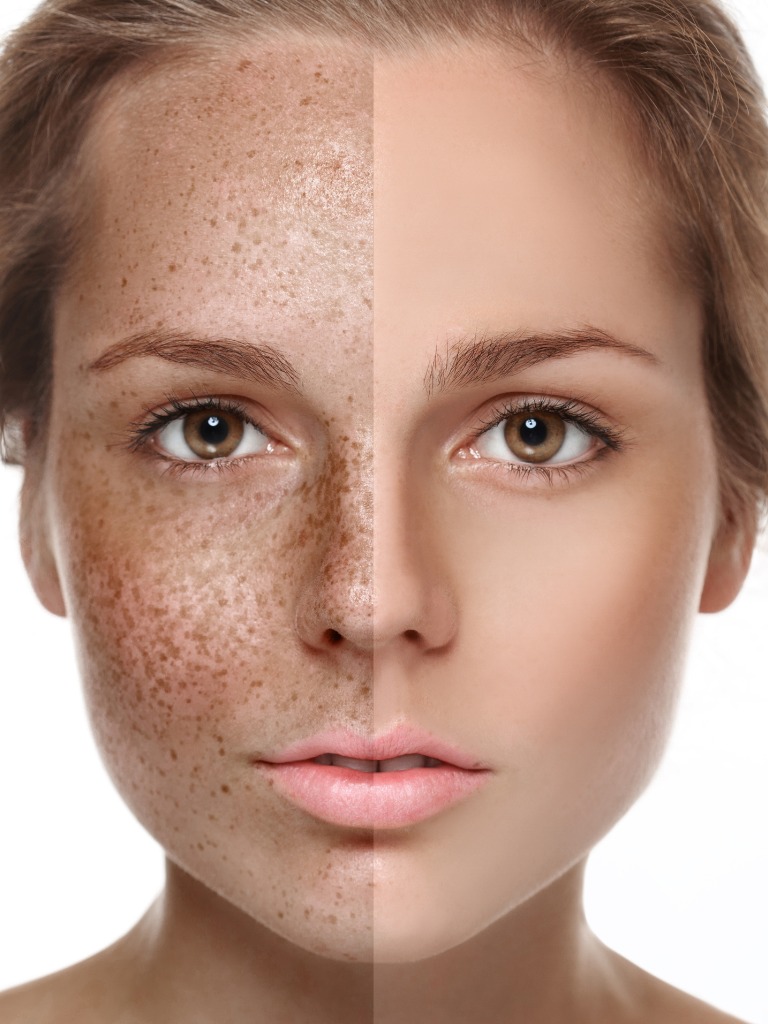Dermatologists refer to two aging processes. The first they call intrinsic—it’s the natural slowing-down of collagen production, which makes your skin less elastic. The second is the one we have more control over. It’s called extrinsic, and it’s aging accelerated by exposure to external factors. Of these factors, the most culpable is sun.
How does exposure to UV rays make you look older? Where do sunspots come from? How does sun affect people with a condition called melasma? (And what even is melasma?) These are questions that require a cellular-level understanding of how our skin gets color.
Melanocytes are cells located in the basal layer—the innermost layer of your skin. They produce what’s called melanin, a word derived from the Greek melanos, meaning dark. Melanin is a pigment, which is just a fancy way of saying biological material that’s colored, and it’s colored because it selectively reflects and absorbs certain light wavelengths. Different amounts of melanin can determine the color of your skin.
The sun actually prompts your body to produce more melanin—it’s why you get bronzed in the summer, because your melanocytes are pumping out the pigment. If your cells are producing too much melanin you can get sunspots, random splotches that aren’t permanent. Sometimes they’re white, if sun damage causes the cells to stop producing melanin, and sometimes they’re darker. Like age spots, sunspots respond well to laser treatment.

For some people, too much sun exposure can bring on and exacerbate a chronic condition called melasma. It’s neither painful nor dangerous but it is long-term, manifesting as blotchy brown spots on the cheeks, chin, forehead, or upper lip.
Melasma derives from a hormonal imbalance. Millions of Americans have it; a lot of them are women who got it during pregnancy or while they were on birth control. Oral contraceptives are a factor in a quarter of cases, and sometimes other medications and even chemical cleaning products can trigger melasma in certain people.
Melasma typically fades after pregnancy or when you stop taking birth control pills. But if it doesn’t, it’s not easy to treat. Hydroquinone lotions work but they can cause dermatitis, a painful redness. Our recommendation for day- to- day bleaching and brightening treatment is Vivant Skincare Bleaching Cream Level 1. For a more aggressive treatment (which can be done after using a Hydroquinone solution) is either an IPL laser treatment or the Zo Skin Health 3 Step Peel by Obagi. Both of these treatments must be done by an esthetician, licensed clinic, or dermatologists office.


Microdermabrasion or chemical peels such as those listed above can help remove damaged skin cells, though the risk is that the pigments might become inflamed. Again, for women, melasma is hormonal therefore it can flare up and appear darker at times particularly during your menstrual cycle. Treating sun damage and melasma with more aggressive treatments can also leave your skin much more sensitive and vulnerable. If you are not careful, the damage from the sun can be exponential. The best times to treat this is during the fall and winter.
As scientists attempt to find better solutions, the most effective way to prevent both a melasma flare-up and accelerated aging in general is to wear sunscreen, every day and in every season. In addition, hats are recommended as well as staying in the shade as much as possible. There are even hats that have UV protection to further shield your skin. Smog and pollution are both culprits in depleting our protective ozone layer, making us more exposed to greater sun damage including skin cancer. Being diligent about your broad-spectrum protection is not only the best way to protect your skin—it’s also the cheapest.